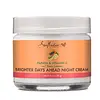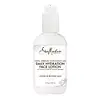What's inside
What's inside
 Key Ingredients
Key Ingredients

 Benefits
Benefits

 Concerns
Concerns

 Ingredients Side-by-side
Ingredients Side-by-side

Water
Skin ConditioningCaprylic/Capric Triglyceride
MaskingGlycerin
HumectantCoco-Caprylate/Caprate
EmollientCetyl Alcohol
EmollientCetearyl Olivate
Butyrospermum Parkii Butter
Skin ConditioningSorbitan Olivate
EmulsifyingStearyl Alcohol
EmollientGlyceryl Stearate Citrate
EmollientCetearyl Alcohol
EmollientRicinus Communis Seed Oil
MaskingHydrogenated Vegetable Oil
EmollientCitrus Aurantium Dulcis Peel Oil
MaskingAscorbic Acid
AntioxidantCarica Papaya Fruit Extract
Skin ConditioningCitrus Junos Fruit Extract
Skin ConditioningLactic Acid
BufferingSodium Hyaluronate
HumectantTocopherol
AntioxidantAllantoin
Skin ConditioningSodium PCA
HumectantHydroxyproline
Skin ConditioningProline
Skin ConditioningPanthenol
Skin ConditioningSodium Starch Octenylsuccinate
AbsorbentGlycine Soja Oil
EmollientSilica
AbrasiveEthylhexylglycerin
Skin ConditioningXanthan Gum
EmulsifyingGlyceryl Caprylate
EmollientTriethyl Citrate
MaskingBenzoic Acid
MaskingPhenoxyethanol
PreservativeWater, Caprylic/Capric Triglyceride, Glycerin, Coco-Caprylate/Caprate, Cetyl Alcohol, Cetearyl Olivate, Butyrospermum Parkii Butter, Sorbitan Olivate, Stearyl Alcohol, Glyceryl Stearate Citrate, Cetearyl Alcohol, Ricinus Communis Seed Oil, Hydrogenated Vegetable Oil, Citrus Aurantium Dulcis Peel Oil, Ascorbic Acid, Carica Papaya Fruit Extract, Citrus Junos Fruit Extract, Lactic Acid, Sodium Hyaluronate, Tocopherol, Allantoin, Sodium PCA, Hydroxyproline, Proline, Panthenol, Sodium Starch Octenylsuccinate, Glycine Soja Oil, Silica, Ethylhexylglycerin, Xanthan Gum, Glyceryl Caprylate, Triethyl Citrate, Benzoic Acid, Phenoxyethanol
Water
Skin ConditioningCaprylic/Capric Triglyceride
MaskingButyrospermum Parkii Butter
Skin ConditioningGlyceryl Stearate
EmollientGlycerin
HumectantCetyl Alcohol
EmollientStearyl Alcohol
EmollientGlyceryl Stearate Citrate
EmollientCetearyl Alcohol
EmollientGlyceryl Caprylate
EmollientCocos Nucifera Fruit Juice
EmollientAcacia Senegal Gum Extract
Cola Acuminata Seed Extract
Skin ConditioningAloe Barbadensis Leaf Juice
Skin ConditioningCocos Nucifera Oil
MaskingCocos Nucifera Fruit Extract
EmollientCamellia Sinensis Leaf Extract
AntimicrobialChamomilla Recutita Flower Extract
MaskingBisabolol
MaskingGlyceryl Undecylenate
EmollientParfum
MaskingWater, Caprylic/Capric Triglyceride, Butyrospermum Parkii Butter, Glyceryl Stearate, Glycerin, Cetyl Alcohol, Stearyl Alcohol, Glyceryl Stearate Citrate, Cetearyl Alcohol, Glyceryl Caprylate, Cocos Nucifera Fruit Juice, Acacia Senegal Gum Extract, Cola Acuminata Seed Extract, Aloe Barbadensis Leaf Juice, Cocos Nucifera Oil, Cocos Nucifera Fruit Extract, Camellia Sinensis Leaf Extract, Chamomilla Recutita Flower Extract, Bisabolol, Glyceryl Undecylenate, Parfum
Ingredients Explained
These ingredients are found in both products.
Ingredients higher up in an ingredient list are typically present in a larger amount.
This ingredient is also known as shea butter. It is an effective skin hydrator and emollient.
Emollients help soothe and soften your skin. It does this by creating a protective film on your skin. This barrier helps trap moisture and keeps your skin hydrated. Emollients may be effective at treating dry or itchy skin.
Shea butter is rich in antioxidants. Antioxidants help fight free-radicals, or molecules that may harm the body. It is also full of fatty acids including stearic acid and linoleic acid. These acids help replenish the skin and keep skin moisturized.
While Shea Butter has an SPF rating of about 3-4, it is not a sunscreen replacement.
Shea butter may not be fungal acne safe. We recommend speaking with a professional if you have any concerns.
Learn more about Butyrospermum Parkii ButterThis ingredient is an emollient, solvent, and texture enhancer. It is considered a skin-softener by helping the skin prevent moisture loss.
It helps thicken a product's formula and makes it easier to spread by dissolving clumping compounds.
Caprylic Triglyceride is made by combining glycerin with coconut oil, forming a clear liquid.
While there is an assumption Caprylic Triglyceride can clog pores due to it being derived from coconut oil, there is no research supporting this.
Learn more about Caprylic/Capric TriglycerideCetearyl alcohol is a mixture of two fatty alcohols: cetyl alcohol and stearyl alcohol. It is mainly used as an emulsifier. Emulsifiers help prevent the separation of oils and products. Due to its composition, it can also be used to thicken a product or help create foam.
Cetearyl alcohol is an emollient. Emollients help soothe and hydrate the skin by trapping moisture.
Studies show Cetearyl alcohol is non-toxic and non-irritating. The FDA allows products labeled "alcohol-free" to have fatty alcohols.
This ingredient is usually derived from plant oils such as palm, vegetable, or coconut oils. There is debate on whether this ingredient will cause acne.
Due to the fatty acid base, this ingredient may not be Malassezia folliculitis safe.
Learn more about Cetearyl AlcoholCetyl Alcohol is a fatty alcohol. Fatty Alcohols are most often used as an emollient or to thicken a product.
Its main roles are:
Though it has "alcohol" in the name, it is not related to denatured alcohol or ethyl alcohol.
The FDA allows products labeled "alcohol-free" to have fatty alcohols.
Learn more about Cetyl AlcoholGlycerin is already naturally found in your skin. It helps moisturize and protect your skin.
A study from 2016 found glycerin to be more effective as a humectant than AHAs and hyaluronic acid.
As a humectant, it helps the skin stay hydrated by pulling moisture to your skin. The low molecular weight of glycerin allows it to pull moisture into the deeper layers of your skin.
Hydrated skin improves your skin barrier; Your skin barrier helps protect against irritants and bacteria.
Glycerin has also been found to have antimicrobial and antiviral properties. Due to these properties, glycerin is often used in wound and burn treatments.
In cosmetics, glycerin is usually derived from plants such as soybean or palm. However, it can also be sourced from animals, such as tallow or animal fat.
This ingredient is organic, colorless, odorless, and non-toxic.
Glycerin is the name for this ingredient in American English. British English uses Glycerol/Glycerine.
Learn more about GlycerinGlyceryl Caprylate comes from glycerin and caprylic acid, a fatty acid from coconut. It has emollient and emulsifier properties.
As an emollient, it helps hydrate your skin. Emollients work by creating a barrier on your skin to trap moisture in, helping to keep your skin soft and smooth.
On the other hand, emulsifiers prevent ingredients (such as oil and water) from separating.
Learn more about Glyceryl CaprylateGlyceryl Stearate Citrate is a citric acid ester of glyceryl stearate.
It is an emulsifier, emollient, and a surfactant.
Emulsifiers help stabilize a product. It does this by preventing certain ingredients from separating. Common ingredients include oils and water, which do not mix naturally. Emulsifiers have properties that help keep ingredients such as these together.
Emollients help soothe and soften the skin. They do this by creating a protective film on your skin. This barrier helps trap moisture and keeps your skin hydrated. Emollients may be effective at treating dry or itchy skin.
Surfactants help gather oils, dirt, and other pollutants from the skin. This helps them to be easily rinsed away.
Learn more about Glyceryl Stearate CitrateStearyl Alcohol is a type of fatty alcohol from stearic acid. It is a white, waxy compound used to emulsify ingredients.
Fatty Alcohols are most often used as an emollient or to thicken a product. Emollients help soothe and hydrate the skin by trapping moisture.
They are usually derived from natural fats and oils and therefore do not have the same drying or irritating effect as solvent alcohols. FDA allows products labeled "alcohol-free" to have fatty alcohols.
Learn more about Stearyl AlcoholWater. It's the most common cosmetic ingredient of all. You'll usually see it at the top of ingredient lists, meaning that it makes up the largest part of the product.
So why is it so popular? Water most often acts as a solvent - this means that it helps dissolve other ingredients into the formulation.
You'll also recognize water as that liquid we all need to stay alive. If you see this, drink a glass of water. Stay hydrated!
Learn more about Water